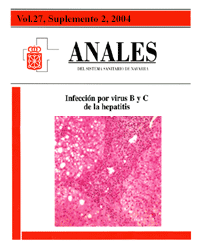Liver transplantation in patients with cirrhosis secondary to Hepatitis B Virus and Hepatitis C Virus injections
Keywords:
Trasplante hepático. Virus B. Virus C. Cirrosis.Abstract
Liver cirrhosis main related to hepatitis C virus constitutes the main indication of liver transplantation in Europe and the USA, representing as many as 50% of the indications in adults, while cirrhosis associated with hepatitis B virus represents around 10%. The indications for transplantation in patients with infection by both viruses are fulminant hepatitis, decompensated cirrhosis and hepatocellular carcinoma. Both injections may relapse after transplantation. The evolution of the relapse in the graft is variable and can include non-significant alterations of the liver junction tests, chronic active hepatitis and cirrhosis. Less frequently, a particularly severe form called “fibrosing cholestatic hepatitis” can develope, which rapidly evolve to graft faillure. The immunoglobin against the B virus and lamivudine reduce the risk of reinfection. The principal factor associated with reinfection is active viral replication before the transplantation, thus it is considered a contraindication for liver transplantation. INF-a has been used in the treatment of hepatitis B virus reinfection with discouraging results. More recently, lamivudine and adefovir have been used. Post-transplantation recurrence of hepatitis C is universal and its evolution towards cirrhosis is more rapid than in immunocompetent patients, with graft dysfunction being the most frequent cause of mortality and of indication for retransplantation. Different factors have been related to the severity of the recurrence including factors related to the donor, the recipient, the virus, immunosuppression and surgery. There are no preventive treatments against recurrence of post-transplantation hepatitis C. In the treatment of the hepatitis C virus recurrence, INF-a and rivabirin have been used in single form or in combination with variable results, with the combined therapy being more effective. Recently, encouraging results have been described with the combination of pegylated interferon and rivabirin without a higher incidence of rejection. Finally, the results of retransplantation in patients with recurrent hepatitis B or C have not been encouraging.Downloads
Downloads
Published
How to Cite
Issue
Section
License
La revista Anales del Sistema Sanitario de Navarra es publicada por el Departamento de Salud del Gobierno de Navarra (España), quien conserva los derechos patrimoniales (copyright ) sobre el artículo publicado y favorece y permite la difusión del mismo bajo licencia Creative Commons Reconocimiento-CompartirIgual 4.0 Internacional (CC BY-SA 4.0). Esta licencia permite copiar, usar, difundir, transmitir y exponer públicamente el artículo, siempre que siempre que se cite la autoría y la publicación inicial en Anales del Sistema Sanitario de Navarra, y se distinga la existencia de esta licencia de uso.








